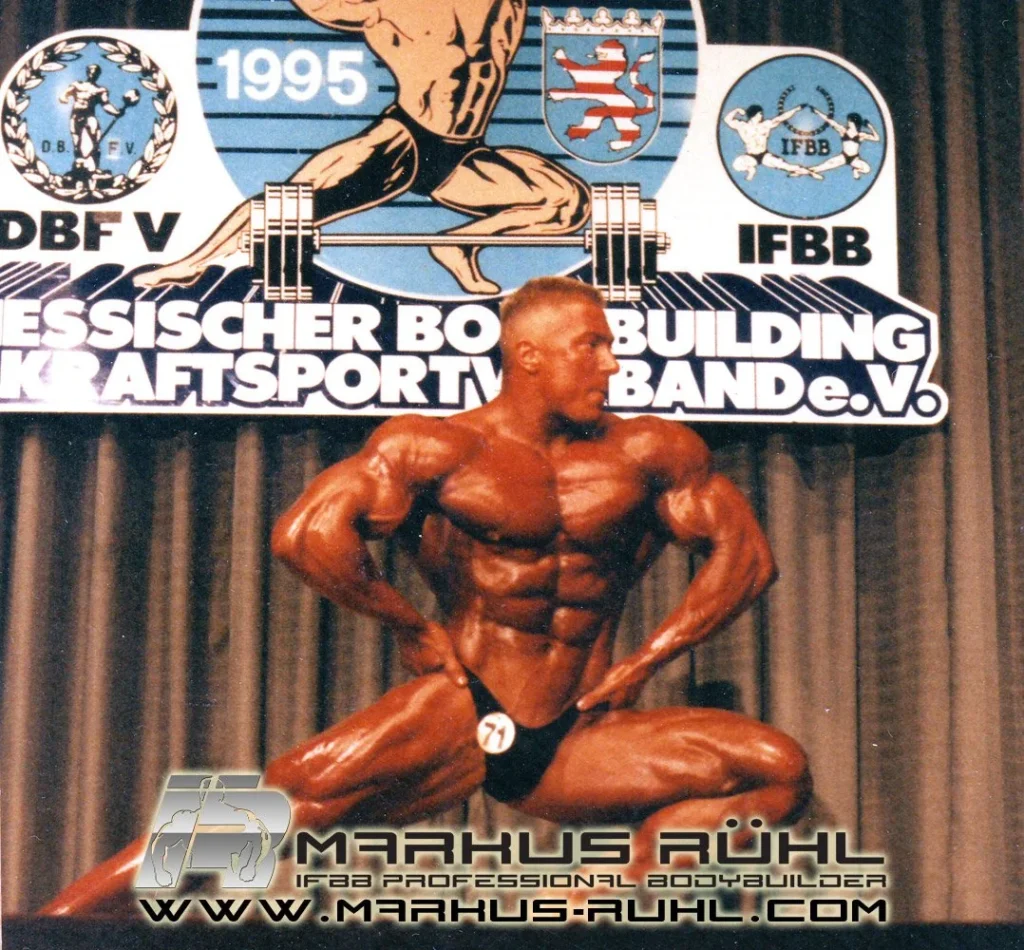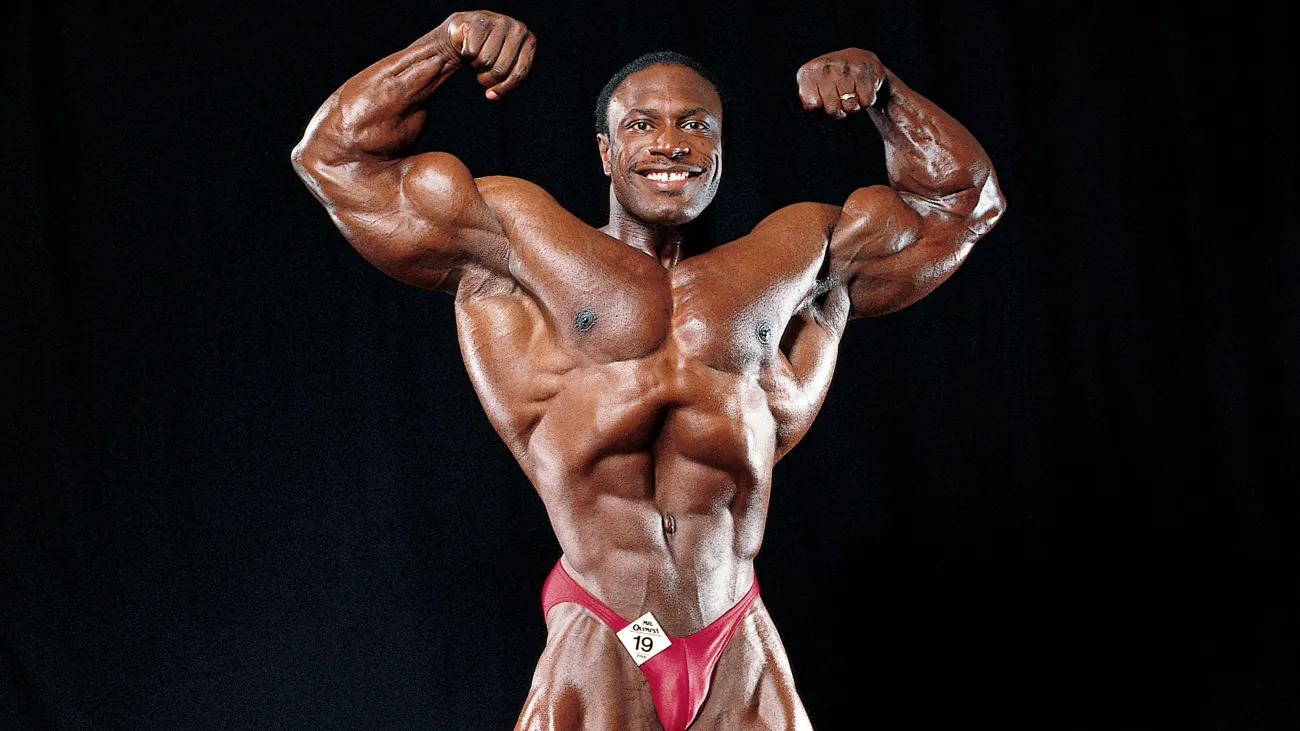In the world of bodybuilding, where mass, symmetry, and definition reign supreme, few names evoke as much awe and admiration as Markus Rühl. Known as “The Freak,” Rühl’s sheer size and unique approach to the sport have left an indelible mark on the industry. His journey from a young German man with aspirations to one of the most massive competitors on the Mr. Olympia stage is both inspiring and fascinating.

Body Features & Stats (at peak condition):
- Height: 5 ft 10 in (178 cm)
- Off-Season Weight: Around 320 lbs (145 kg)
- Competition Weight: Approximately 285 lbs (129 kg)
- Arms (Biceps): 24 inches (61 cm)
- Chest: 60 inches (152 cm)
- Waist: 36 inches (91 cm)
- Thighs: 32 inches (81 cm)
- Calves: 22 inches (56 cm)
Distinctive Features:
- Extreme Upper Body Mass: Rühl was known for his enormous shoulders, chest, and arms. His delts were particularly famous for their size and roundness.
- Wide Frame: His wide clavicles and thick chest gave him an imposing presence on stage, often out-sizing other competitors even if his conditioning wasn’t always as sharp.
- Veiny and Muscular Arms: His arms were not just huge but highly vascular and defined, contributing to his “freak factor” appeal.
- Conditioning: While Rühl was known more for his size than his conditioning, in his best shape (like during the 2002 Night of Champions, which he won), he managed to combine both size and decent conditioning, making him nearly unstoppable.

Best Condition Highlight:
Markus Rühl’s most notable victory was at the 2002 Night of Champions, where he displayed an unparalleled combination of mass and definition. This is often cited as his best conditioning and peak performance.
He retired from competitive bodybuilding in 2010 but remains a prominent figure in the bodybuilding community, known for his personality and freakish size during his prime.
Markus Rühl, a retired German professional bodybuilder known for his massive size and impressive conditioning, experienced several injuries throughout his career, but his most notable one was a severe chest injury. Early in his bodybuilding journey, Rühl tore his pectoral muscle during a heavy bench press session. This injury was significant enough to require surgery and left a noticeable imbalance in his chest development, something that fans and critics often pointed out during competitions.
Despite the injury, Rühl continued to compete at a high level, becoming one of the most recognizable mass monsters in the sport. His perseverance and ability to maintain such a massive physique despite setbacks made him a fan favorite.

Early Life and Introduction to Bodybuilding
Markus Rühl was born on February 22, 1972, in Darmstadt, West Germany. Unlike many of his peers, Rühl didn’t begin his athletic journey in the gym. In fact, he was a relatively late bloomer in the bodybuilding scene. Initially, he pursued a career in soccer, but a knee injury at the age of 18 forced him to reconsider his athletic ambitions. During his recovery, Rühl discovered weight training, a decision that would change the trajectory of his life forever.

The Transformation
What started as a means to stay fit during rehabilitation quickly became a passion. Rühl’s natural ability to build muscle was evident from the start. His dedication to training, coupled with his unique genetics, allowed him to gain size rapidly. Within a few years, Markus transitioned from a novice lifter to a serious competitor in the German bodybuilding circuit.
By the mid-1990s, Rühl’s name began to gain traction in the international bodybuilding community. His breakthrough came when he won the IFBB German Nationals in 1995, earning his pro card and solidifying his status as a force to be reckoned with.

The Freak Factor
Markus Rühl’s nickname, “The Freak,” wasn’t given lightly. Standing at 5’10″ and competing at over 280 pounds in contest shape, Rühl was one of the largest bodybuilders of his time. His massive shoulders, thick chest, and incredible arm development set him apart from his contemporaries. While many competitors focused on achieving the perfect balance of size and aesthetics, Rühl embraced the sheer mass monster look, pushing the boundaries of what was considered possible in bodybuilding.
One of Rühl’s most famous features was his incredible deltoid development. His shoulders were so large and round that they seemed almost unreal, giving him a distinctive silhouette on stage. Fans and judges alike were captivated by his impressive physique, though his extreme size sometimes worked against him in competitions where symmetry and proportion were heavily emphasized.
Competitive Career
Markus Rühl’s professional career spanned over a decade, with numerous notable achievements. He competed in multiple Mr. Olympia contests, with his best finish being 5th place in 2004. While he never claimed the coveted Sandow trophy, his presence on stage was undeniable, and he quickly became a fan favorite.
Some of Rühl’s other significant accomplishments include winning the 2000 Toronto Pro and the 2002 Night of Champions. These victories showcased his dominance and solidified his reputation as one of the top bodybuilders of his era.
Markus Rühl’s Professional Competition History:
- 1997 Grand Prix Germany – 10th Place
- 1999 Night of Champions – 7th Place
- 1999 Mr. Olympia – 12th Place
- 2000 Toronto Pro Invitational – 2nd Place
- 2000 Night of Champions – 5th Place
- 2000 Mr. Olympia – 7th Place
- 2001 Night of Champions – 2nd Place
- 2001 Mr. Olympia – 14th Place
- 2002 Night of Champions – 1st Place (Markus’s biggest professional win)
- 2002 Mr. Olympia – 8th Place
- 2003 Arnold Classic – 3rd Place
- 2004 Mr. Olympia – 5th Place (his best Mr. Olympia placement)
- 2005 Mr. Olympia – 15th Place
- 2006 Austria Pro Grand Prix – 3rd Place
- 2006 Grand Prix Australia – 3rd Place
- 2006 Mr. Olympia – 8th Place
- 2009 IFBB New York Pro – 3rd Place
- 2010 IFBB Europa Super Show – 7th Place
Key Highlights:
- Best Victory: 2002 Night of Champions (1st Place) – This was his standout win, where he displayed an insane combination of size and good conditioning.
- Best Mr. Olympia Finish: 2004 Mr. Olympia (5th Place) – Despite fierce competition, Rühl broke into the top 5 at the sport’s most prestigious event.

Retirement:
Markus Rühl retired from professional bodybuilding after his final competition in 2010. Post-retirement, he’s remained active in the bodybuilding scene through guest appearances, coaching, and his supplement company, Rühl’s Bestes.
Training Philosophy and Work Ethic
Markus Rühl’s training regimen was as intense as his physique suggested. Known for his heavy lifting and high-volume workouts, Rühl believed in pushing his body to the absolute limit. His dedication to the gym was unparalleled, often spending hours perfecting his craft.
Rühl’s approach to diet and supplementation was equally rigorous. He understood the importance of nutrition in building and maintaining his massive frame, adhering to strict meal plans and ensuring he consumed the necessary nutrients to fuel his intense training sessions.

Legacy and Impact on Bodybuilding
While Markus Rühl may not have a Mr. Olympia title to his name, his impact on the sport is undeniable. He redefined the standards of size and mass in bodybuilding, inspiring countless aspiring athletes to push their limits. His unique physique and larger-than-life personality made him a beloved figure in the bodybuilding community.
Beyond his competitive achievements, Rühl has remained active in the fitness industry. He continues to inspire through guest appearances, seminars, and social media, sharing his knowledge and passion for bodybuilding with fans worldwide.
Your Instagram: https://www.instagram.com/markusruehl/
Conclusion
Markus Rühl’s journey from a soccer player recovering from injury to one of the most massive bodybuilders in history is a testament to his determination, work ethic, and passion for the sport. Known as “The Freak,” Rühl embraced his unique physique and left an indelible mark on bodybuilding. His legacy serves as a reminder that with dedication and perseverance, it’s possible to achieve greatness, even in the most competitive arenas.


